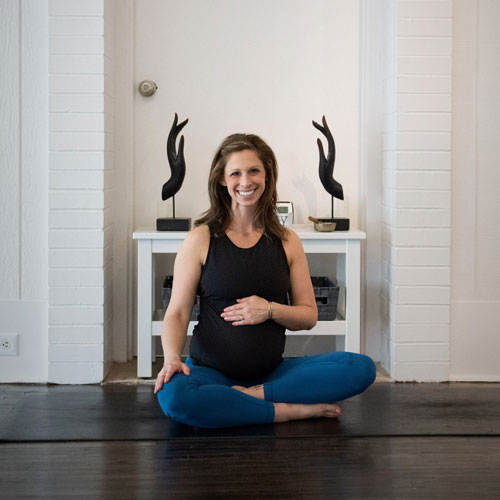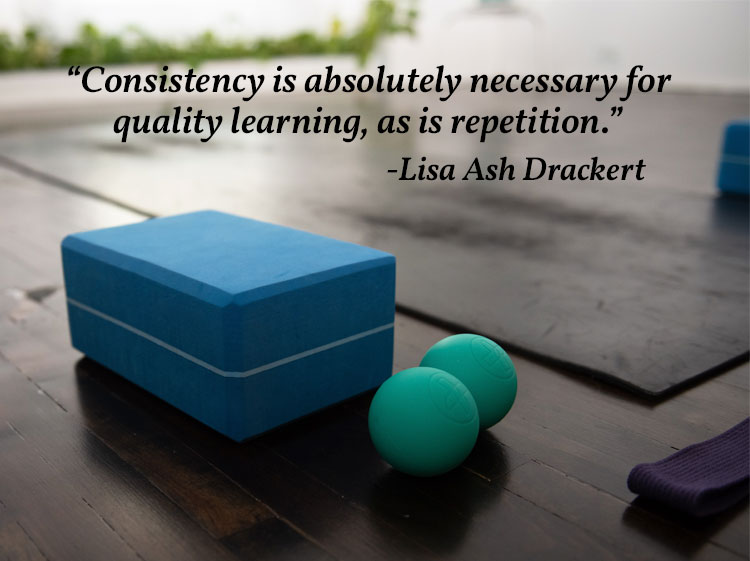 Once you leave a teacher training program, you often find very little formal structure in the actual teaching of yoga to students. Yet a spontaneous and disjointed approach to yoga instruction can make it challenging for many to internalize the many benefits of the practice.
Once you leave a teacher training program, you often find very little formal structure in the actual teaching of yoga to students. Yet a spontaneous and disjointed approach to yoga instruction can make it challenging for many to internalize the many benefits of the practice.
The flip side is that deep learning can happen with a more structured yoga education plan. And the owner of Westport Yoga in Kansas City shows you how in this article!
I first met Lisa Ash Drackert at a Yoga for Athletes training in Nashville at the end of last year. She was at the event sharing her knowledge about working with football players. More specifically, Lisa works with lineman of the Kansas City Chiefs. You know? The team that won the Superbowl this year!?!
Anyway, it was only after we got on the phone together that I discovered her background in education. And since you know I’m completely passionate about ongoing learning, I knew I had to share her take on yoga education with you!
Thus, this entire article was born.
Photo Credit: Chloe Virginia Photography
MEET LISA DRACKERT
Lisa Drackert is a powerhouse entrepreneur that wears numerous hats. As a teacher, she spins creative and energetic flow classes. As a leader, she inspires her teachers to even more greatness in their lives. And as a therapeutic specialist, Lisa provides hopeful pathways for her clients to heal.
 Her ability to teach a wide array of students started long before Westport Yoga KC was on her radar. Lisa has university degrees in Education, Psychology, and Religious Studies. She also holds a Masters in Education from the University of Missouri-Kansas City. And she spent 3 years in the classroom as a first grade teacher. (Plus 2 more years working as a Teacher Mentor in schools through a non-profit organization).
Her ability to teach a wide array of students started long before Westport Yoga KC was on her radar. Lisa has university degrees in Education, Psychology, and Religious Studies. She also holds a Masters in Education from the University of Missouri-Kansas City. And she spent 3 years in the classroom as a first grade teacher. (Plus 2 more years working as a Teacher Mentor in schools through a non-profit organization).
Life began to change course when Lisa took on the manager position at Westport Yoga KC. She gradually took over all of the studio responsibilities. Then, Lisa decided to purchase the business when it went up for sale.
It was at this point that Lisa created an entirely new yoga education program for the studio.
“I’m a huge proponent of [yoga] teachers becoming better educators. And my biggest goal in the community is to transform how we perceive the entire process of learning.”
Yes, she pays her teachers to take classes at the studio. Westport Yoga KC gives scholarships each year that staff can put toward continuing education programs of their choice. And Lisa has developed an incredible yoga curriculum that increases cohesion, confidence, and time in the planning process.
Do you want to know how she does this?
Keep reading to discover how these simple teaching tools can be used to greatly increase your team effectiveness and student retention over time!
ESTABLISH A CONTRACT
Yes, it’s true, that most yoga studios and yoga teachers sign contracts to understand the terms of agreement when teaching. But what contract are you signing with your students? How do they know exactly what you are offering? And what will they get as a result of your teaching?
When I taught at Sports Kinesiology and yoga at Chico State, the class syllabus was my contract with students. This document clarified what was to be taught each semester. And it told students exactly what was expected of them if they wanted a passing grade.
At Westport Yoga KC, Lisa has created an annual yoga curriculum that serves as a contract between her staff and her students. This yoga curriculum has 12 modules (one for each month) Each of these are rooted in the Yoga Sutras and the entire program is publicly posted on the website for all to see.
The benefits of a Yoga Curriculum:
- Students pay tuition (class/membership fees) in exchange for learning yoga
- Student commitment levels increase
- Teacher engagement skyrockets
- Everyone is on the same page (from owner to manager to staff to students)
- Students are more likely to do homework (aka practice yoga principles) off of the mat
WORK WITHIN A STRUCTURE
Lisa was once a first grade teacher. And, as she reiterated during our conversation, schools do not hire teachers (at any grade) to come in and teach whatever they want for the day. School systems approve a curriculum for each grade level. They then have a lead teacher who supports each individual teacher out in the field.
That’s not to say that all teachers must perform like robots in the classroom. Quite the opposite, in fact. Each individual teacher has the freedom to infuse their own personality and teaching style into how they present that information to their students. Teachers have the flexibility to teach those core concepts in unique ways. Basically, they get to teach the content in their own way.
This is also true at Westport Yoga KC.
The studio curriculum contains core concepts that each person on the teaching staff adheres to each month. Then instructors get to be creative in how they teach that content. They get to design creative yoga sequences that match their personal style, preferences, and student base.
Everybody wins in this set-up because:
- Owners and managers ensure high-quality teaching is being done at their location
- There is a strong sense of cohesion within the entire team
- Teachers get freedom to express themselves as an independent teacher, and
- Students become familiar with concepts, regardless of the instructor and class time they choose to select for their practice

HIGHLIGHT PRIMARY CONCEPTS
One of Lisa’s biggest goals at Westport Yoga KC is to ensure yoga teachers are also great educators. What does this mean? Yoga is taught in a way that students internalize knowledge they gain on the mat and can transfer it into their everyday lives.
To do this, it’s beneficial to highlight primary concepts during each class. This means you select a main idea to share with your students, such as a Yama or Niyama. Then, a secondary concept such as mindfulness is also taught. When these boarder yoga ideas are paired together, students can understand how these concepts fit together (both on and off of the mat).
How to ensure your staff teaches these concepts
There are many effective ways to ensure your staff is passing on your effective yoga education plan. Here’s what Lisa does at her studio:
Print a Manual
Each year, the yoga curriculum is revised at Westport Yoga KC. Whether you are a new teacher who just received onboarding at the yoga studio or the longest-running instructor on the schedule, you get a new manual that highlights the concepts of the yoga curriculum.
Have a Communal Library
Lisa’s yoga curriculum includes a list of required reading for staff members. This not only deepens the education of each teacher, but gives practical and personal ways for each teacher to share the concepts with their students.
But creating a home library can be expensive and impractical for teachers. Instead, have a communal library at the studio that teachers can access throughout the year. Click here to check out some of my favorite books for yogis as well.
Give Positive Feedback
Once per quarter, Lisa visits a class led by one of her incredible teachers. Only she doesn’t do this to make her teachers nervous. Her goal is to help her staff feel supported and give them real-time, positive feedback so they can continue down the road to mastery as a yoga professional.
ADDRESS ALL LEARNING STYLES
The most basic way students learn the core content of a yoga curriculum is through the unique sequences prescribed by each teacher. And students pick up yoga via their senses; three main senses to be specific.
Students learn by seeing the poses. This is the visual sense, and learning happens through sight when you demonstrate at the front of the room. And, students learn by looking around at what others are doing in the room.
Yoga is also absorbed through what is heard. This refers to the auditory sense. Each verbal cue you offer in class, each instruction for proper alignment, and each inspirational phrase teaches students about yoga.
Most commonly, though, students learn just by moving their bodies through each asana on the mat. They internalize what they see in the room and the words you say into their bodies, which can be memorized at the cellular level.
EMBRACE THE RULE OF 3
The real memorization process, though, happens via the Rule of Three. This starts when you learn something new. It’s when you’re exposed to fresh information and new neural networks start to form in the brain.
Then, you have to practice what you have learned. Science demonstrates neural networks can start to prune apart in as little as 24 hours. Basically, repetition is what stores your knowledge long term, and gives you the ability to access that information more readily.
This naturally leads to the third part of the learning process where your effective yoga education is internalized by students.
The benefits of using the rule of 3?
Students not only retain what they have been taught, but they can relate their yoga knowledge to other areas of their life. Said another way, they can actually use their yoga knowledge outside of the studio walls when they need it.
Your students will have confidence to use a familiar pranayama technique during a stressful situation at work. Or, they’ll have the grace and serenity to handle a challenging client. The best part about this is that students become empowered in their own practice of yoga. And they often have a deeper love of learning on the mat for the future.
PUTTING IT TOGETHER
Lisa Drackert, owner of Westport Yoga KC, is paving the way for effective yoga education. In a recent interview, she reveals how these simple elements can heighten how your students learn yoga. This all starts with creating a yoga curriculum and establishing a structure in which you teach core concepts. Then, ensure students get lots of time to learn with eyes, ears, and the whole body over and over again. Think specific practice… over and over for empowering results.
Take Action Now:
- Download a sample curriculum guide below.
- Set a curriculum for your classes for the next month, and notice how the yoga sequences you select enhance the learning process for your students.
- Join Lisa at a Westport Yoga KC for ongoing training yourself. They have amazing Advanced Yoga Teacher Training Modules that offer Continuing Education Credits through Yoga Alliance. Check out their upcoming schedule now!










Leave A Comment